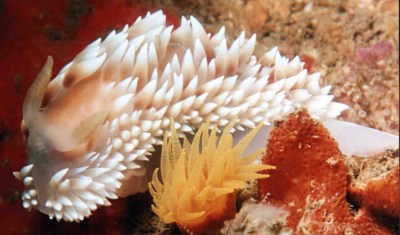
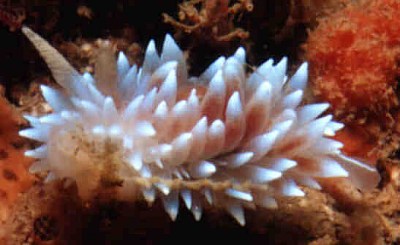
Janolus capensis
Bergh, 1907
Order: NUDIBRANCHIA
Suborder: ARMININA
Family: Zephyrinidae
DISTRIBUTION
Cape Province, South Africa.
PHOTO
Brazen Head, Transkei, SOUTH AFRICA - 28m. June 2000. UPPER PHOTO: = 60mm; LOWER PHOTO: = 20mm. Photos: Valda Fraser.
Apparently endemic to the southern tip of Africa. It feeds on the arborescent bryozoans Menipea triseriata and Onchoporella bushii and has been found from the intertidal to 40m. It is very similar in colour externally to Janolus longidentatus Gosliner, 1981. There are numerous anatomical differences but one 'external' difference is the shape of the eggmass. In J. capensis it is convoluted and globular with numerous (30-40) eggs per capsule, while in J. longidentatus the egg mass is a flat spiral with only 5-7 eggs per capsule. (Gosliner, 1981).
Reference:
• Gosliner, T.M. (1981) The south African Janolidae (Mollusca, Nudibranchia) with the description of a new genus and two new species. Annals of the South African Museum, 86(1): 1-42.
Rudman, W.B., 2000 (July 9) Janolus capensis Bergh, 1907. [In] Sea Slug Forum. Australian Museum, Sydney. Available from http://www.seaslugforum.net/find/janocape
Related messages
Janolus capensis from False Bay, Sth Africa
June 23, 2005
From: Wilhelm van Zyl
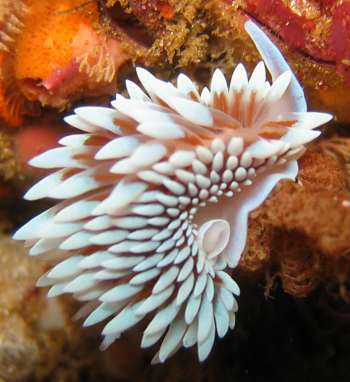
Hi Bill
Concerning your comments about the other animal [#14092 ]:
It was actually this ridge or absence thereof that made me think it was Bonisa. I cannot see any ridge between the rhinophores in that picture. On my next dive I will specifically look for this. Another thing that made me wonder was the shape of the cerata, they are more club shaped than the other Janolus specimens I have.
I do not know if this can be used to differentiate between the 2. I am sending you my best photo of Janolus capensis to date. I took it on a dive site called Castle Rock near Simons Town in False Bay at about 5m water depth. Although you cannot see the ridge I am sure this is Janolus.
Regards
Wilhelm
diving@cyberdale.co.za
van Zyl, W., 2005 (Jun 23) Janolus capensis from False Bay, Sth Africa. [Message in] Sea Slug Forum. Australian Museum, Sydney. Available from http://www.seaslugforum.net/find/14114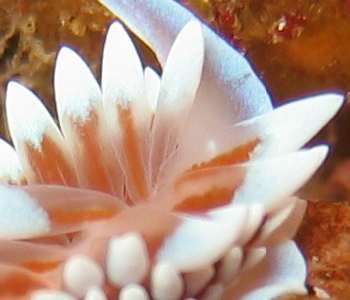
Dear Wilhelm,
The large caruncle between the rhinophores is probably the best bet but as you can't see that in many photos it doesn't help much. I don't think how flattened the cerata are is a good thing to use as their shape is fairly plastic. One very important feature though is whether there is a branch of the digestive gland in the cerata. There is branch in species of Janolus, but not in species of Bonisa. In your photo here the reedish-brown branch, which forks near the tip is quite visible.
Best wishes,
Bill Rudman
Janolus capensis eggs
October 18, 2003
From: Charles Rowe

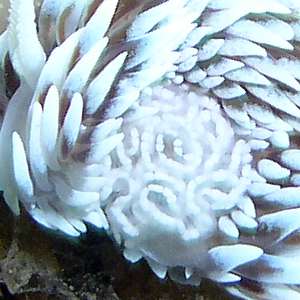
Hi Bill,
Here is an interesting photo from our dive last Saturday. It was taken on 11 October 2003 at Whitesands, Port Elizabeth, South Africa at 14 metres.
You remember asking me about shots of the beasts laying eggs, well this might be doing so. I'm a little dubious as it doesn't
look like a spiral. What do you think?
See ya.
Charles ...
bumff@mweb.co.za
Rowe, C., 2003 (Oct 18) Janolus capensis eggs. [Message in] Sea Slug Forum. Australian Museum, Sydney. Available from http://www.seaslugforum.net/find/11246
Thanks Charles,
This animal is indeed laying its eggs. What looks like a tangle in your photo will look like the ribbon in your earlier message when it is complete. I have included a 'scenic' shot alongside as I am very impressed with the way many of your animals seem to prepare to be photographed by arranging themselve in very photogenic biotopes. I sometimes wish I could include larger images with more background but that would be hugely expensive.
Best wishes
Bill Rudman
Re: Janolus capensis from Port Elizabeth [2]
October 10, 2003
From: Charles Rowe
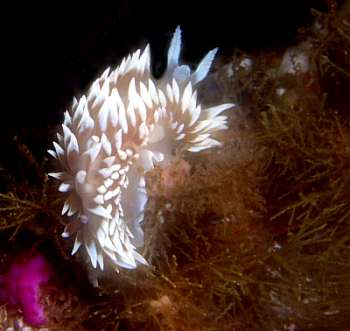
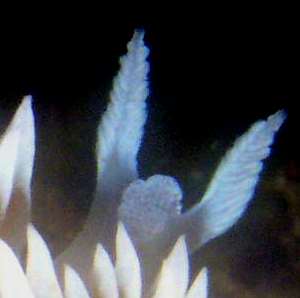
Hi Bill,
Concerning your question about the 'caruncle'. Here is another shot of this species showing the caruncle very clearly. This is possibly the most common species in Port Elizabeth. This is a shot taken at Evans Peak in Port
Elizabeth, South Africa, on 25 January 2003 at 24 metres. The "caruncle" is clearly evident but what use does it serve?
See ya.
Charles
bumff@mweb.co.za
Rowe, C., 2003 (Oct 10) Re: Janolus capensis from Port Elizabeth [2]. [Message in] Sea Slug Forum. Australian Museum, Sydney. Available from http://www.seaslugforum.net/find/11177Thanks Charles,
Good shot of the caruncle. I wish I could tell you what its function is but as far as I know its function is still unknown. You will see it described as 'sensory' but I don't know of any evidence to support that assumption
Best wishes
Bill Rudman
Janolus capensis from Port Elizabeth [2]
October 8, 2003
From: Charles Rowe

Dear Bill,
This is photo is also from Port Elizabeth South Africa. It was taken at a dive site called Thunderbolt on 6 April 2003 at 20 metres.
Thanks,
Charles Rowe
bumff@mweb.co.za
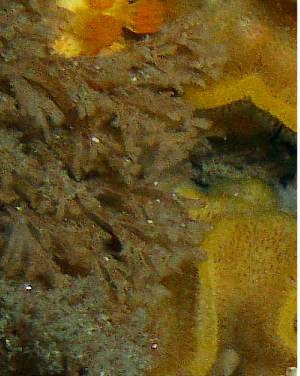
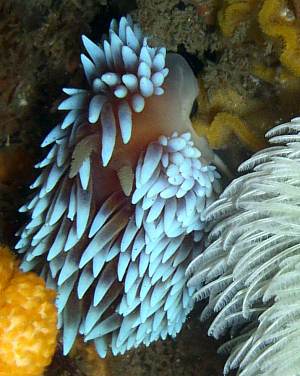
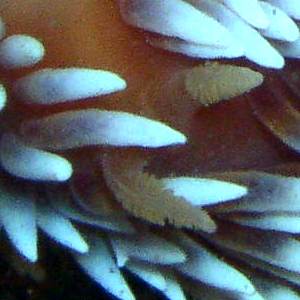
Dear Charles,
I think this is the same species as in your
accompanying message - Janolus capensis. It feeds on arborescent [= plant-like] bryozoan colonies like the one you can see in the left side of the closeup [lower left] I have added to your message. I have also added a closeup to the right of my reply showing the rhinophores. One characteristic of the genus Janolus is that there is a wrinkled ridge [caruncle] between the rhinophores. I can't see any sign of it in your photo and unfortunately one of the cerata is just in the wrong place. Perhaps you have another photo which shows the space on the head between the rhinophores. It would be nice to know if the 'caruncle' is present
Best wishes
Bill Rudman
Janolus capensis from Port Elizabeth
October 8, 2003
From: Charles Rowe
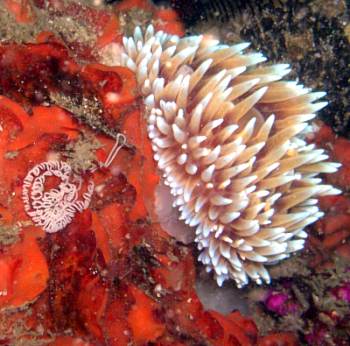
Dear Bill,
Here is a photo taken at Whitesands, Port Elizabeth, South Africa, on 16 February 2003 at 16 metres.
Charles Rowe
bummf@mweb.co.za
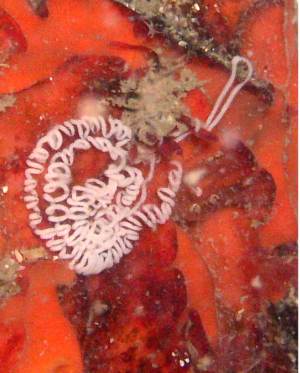
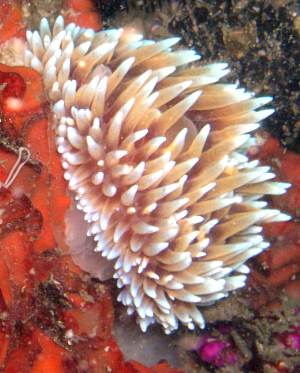
Dear Charles,
I am pretty sure this is Janolus capensis, which according to Terry Gosliner is quite common throughout the year on both the Atlantic and Pacific coasts of the Cape Peninsula. I was not sure if the egg ribbon in your photo was related to the slug, but from Terry's description of the egg ribbon as 'highly convoluted' I would suspect the egg ribbon may well belong to this slug
Best wishes
Bill Rudman
Janolus capensis? from S Africa
February 8, 2003
From: Rudolph van Jaarsveld
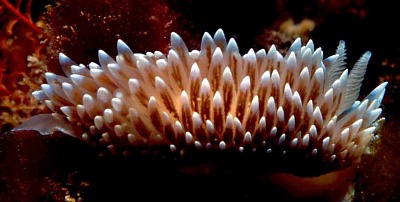
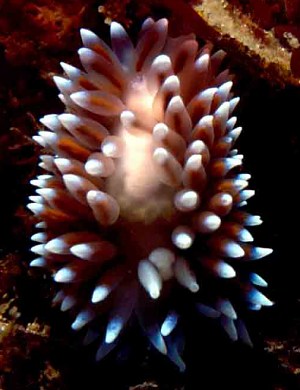
Dear Bill,
Attached please find more photos taken this year [January 2003] off Simon Town in False Bay, South Africa.
Regards.
Rudolph van Jaarsveld
rudolph.vanjaarsveld@tcm.co.za
Van Jaarsveld, R., 2003 (Feb 8) Janolus capensis? from S Africa. [Message in] Sea Slug Forum. Australian Museum, Sydney. Available from http://www.seaslugforum.net/find/9164Dear Rudolph,
The animals in your photos are both species of Janolus, part of a family of nudibranchs which feed on bryozoans. There are two very similarly looking species from South Africa, Janolus capensis and Janolus longidentatus. I am not sure which species these are, or if both photos are of the same species. There are good anatomical differences between the species, and their egg masses are quite different, but unfortunately there general appearance is very similar. Gosliner does say that in J. capensis the anterior end of the head is conical, while in J. longidentatus it is rounded, but unfortunately this can't be see in your photos.
In your upper photo the brown ducts of the digestive gland seem to branch near the base, which is what happens in J. longidentatus, and in the lower photo the crest between the rhinophores is white, which is what has been described for J. capensis, so it is possible that you have both species here, because they are both recorded to feed on the bryozoan Menipea. At this stage I am not sure of the identity of the other photos on this page either, but have decided to leave them all as J. capensis.
Best wishes,
Bill Rudman
Janolus capensis from South Africa
February 2, 2002
From: Erwin Köhler
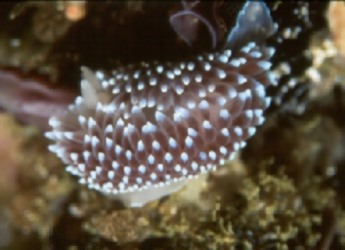
Dear Bill,
Here is a shot from South Africa, False Bay, by Guido Del Giudice
Email: guidodg@iafrica.com
Other data not recorded.
Erwin
Erwin@medslugs.de
Köhler, E., 2002 (Feb 2) Janolus capensis from South Africa. [Message in] Sea Slug Forum. Australian Museum, Sydney. Available from http://www.seaslugforum.net/find/6145Dear Erwin,
I think this is Janolus capensis, which according to Terry Gosliner is one of the common zephyrinids in the Cape Peninsula region of South Africa. There seem to be few external differences between this species and another South African species, Janolus longidentatus Gosliner, 1981, but J. capensis has a white edge to the foot which is visible in Guido's photo.
Best wishes,
Bill Rudman
Janolus capensis from South Africa
July 9, 2000
From: Valda Fraser


Dear Bill
Is this Janolus capensis? Please give your expert opinion. I am sending 2 photos to illustrate colour variation.
Locality: Brazen Head, Transkei, SOUTH AFRICA - 28m
Date: June 2000
Size: UPPER PHOTO:= 60mm
LOWER PHOTO: = 20mm
Thanks.
Regards
Valda
iti04937@mweb.co.za
Fraser, V., 2000 (Jul 9) Janolus capensis from South Africa. [Message in] Sea Slug Forum. Australian Museum, Sydney. Available from http://www.seaslugforum.net/find/2669Dear Valda,
I think it is Janolus capensis but i must say my opinion is not very expert on South African janolids especially when Terry Gosliner says there are few external differences between Janous capensis and Janolus longidentatus Gosliner, 1981. One feature mentioned by Gosliner (1981) is that J. capensis has a translucent whitish body with a white edge to the foot, which can certainly be seen in the lower photo. Another useful character is the shape of the egg mass and the number of eggs per capsule. Have a look at my notes at the top of the page. A photo of any eggs would be a nice thing to add.
Best wishes,
Bill Rudman.
